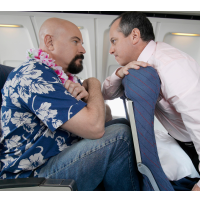Air Rage Incidents more likely when Economy Passengers Pass Through First Class
 (photo: Digital Vision/Getty Images)
(photo: Digital Vision/Getty Images)
Toronto – We blame air rage on long flight delays, shrinking seats and a general decline in civility. But the first empirical research study into the phenomenon pegs another culprit -- class inequality -- for the reason passengers lose it when taking to the so-called friendly skies.
Air rage incidents are more likely when the plane has a first class cabin, says the study by Katy DeCelles of the University of Toronto's Rotman School of Management and Michael Norton of the Harvard Business School. The odds increase when economy passengers have to pass through first class to get to their seats, reinforcing the inequality.
Simply having a first-class compartment made an air rage incident nearly four times more likely, equivalent to the effect of a nine-hour flight delay, the study found. The bad behavior was higher not only for economy passengers, but those in first class too.
Other factors such as crowdedness, alcohol consumption and long flights can contribute to disruptive incidents, says Prof. DeCelles, but her research found their impact was smaller than you might expect.
"I expected there to be more support for a lack of leg room as a contributor to air rage, given the attention that leg room has had -- but there wasn't," says DeCelles, an associate professor of organizational behaviour and human resource management, who is also cross-appointed at U of T's Centre for Criminological Research.
Although the study did not delve into the reasons behind its findings, past research has identified that people tend to have poorer health, well-being and behavioral outcomes when they experience comparative deprivation or feel treated unequally or unfairly. This study contributes to the research by showing that even temporary experiences of inequality can have negative effects.
Prof. DeCelles used a database of thousands of documented disruptive flight incidents over several years for a large international airline. The incidents were serious enough to be considered a threat to onboard safety, such as passengers refusing to sit down, yelling obscenities at a flight attendant or interfering with smoke sensors so they could sneak a cigarette. The majority of incidents involved belligerent behavior or intoxication.
The results have implications for any physical environment where differences in class or status are apparent -- such as a tiered stadium or a workplace where lower-level employees have to pass by executive offices to get to their cubicles. Meanwhile, airlines that want to consider how to reduce negative behavior may want to think about ways to de-emphasize differences between passenger groups, such as using a dual gating system.
"The more you can use those dual gates to board airplanes, separating the first-class cabin from the economy cabin, you're going to have less air rage in both cabins," says Prof. DeCelles.
To Learn More:
Physical and Situational Inequality on Airplanes Predicts Air Rage (by Katherine A. DeCellesa and Michael I. Norton, Proceedings of the National Academy of Sciences) (abstract)
Airline Passengers Push Back against Cramped Conditions…and Each Other (by Noel Brinkerhoff, AllGov)
- Top Stories
- Unusual News
- Where is the Money Going?
- Controversies
- U.S. and the World
- Appointments and Resignations
- Latest News
- Musk and Trump Fire Members of Congress
- Trump Calls for Violent Street Demonstrations Against Himself
- Trump Changes Name of Republican Party
- The 2024 Election By the Numbers
- Bashar al-Assad—The Fall of a Rabid AntiSemite






Comments